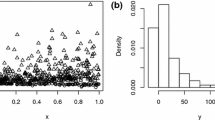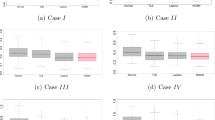Abstract
Models and parameters of finite mixtures of multivariate normal densities conditional on regressor variables are specified and estimated. We consider mixtures of multivariate normals where the expected value for each component depends on possibly non-normal regressor variables. The expected values and covariance matrices of the mixture components are parameterized using conditional mean- and covariance-structures. We discuss the construction of the likelihood function, estimation of the mixture model with regressors using three different EM algorithms, estimation of the asymptotic covariance matrix of parameters and testing for the number of mixture components. Finally, a small simulation study demonstrates good results for the two-stage EM algorithm in retrieving the original parameters.
Access this chapter
Tax calculation will be finalised at checkout
Purchases are for personal use only
Preview
Unable to display preview. Download preview PDF.
Similar content being viewed by others
References
ARMINGER, G. (1995). Specification and estimation of mean structures: Regression models. In Arminger, G., Clogg, C.C. and Sobel, M.E., editors, Handbook of Statistical Modeling for the Social and Behavioral Sciences, 77–183. Plenum, New York.
ARMINGER, G., STEIN, P. and WITTENBERG, J. (1999). Mixtures of condi-tional mean-and covariance structure models. Forthcoming in Psychometrika.
ARMINGER, G., WITTENBERG, J. and SCHEPERS, A. (1996). MECOSA 3 User Guide. Additive GmbH., Friedrichsdorf/Ts., Germany.
BECKER, M.P., YANG, I. and LANGE, K. (1997). EM algorithms without missing data. Statistical Methods in Medical Research, 6, 37–53.
BENTLER, P.M. (1994). EQS 4.0. BMDP Statistical Software, Los
ANGELES. BROWNE, M.W. and ARMINGER, G. (1995). Specification and estimation of mean-and covariance-structure models. In Arminger, G., Clogg, C.C. and Sobel, M.E., editors, Handbook of Statistical Modeling for the Social and Be-havioral Sciences, 185–249. Plenum, New York.
DEMPSTER, A.P., LAIRD, N.M. and RUBIN, D.B. (1977). Maximum likelihood from incomplete data via the EM algorithm (with discussion). Journal of the Royal Statistical Society B, 39, 1–38.
DESARBO, W.S. and CRON, W.L. (1988). A maximum likelihood methodology for clusterwise linear regression. Journal of Classification, 5, 249–282.
JEDIDI, K., JAGPAL, H.S. and DESARBO, W.S. (1997). Finite-mixture structural equation models for response-based segmentation and unobserverd heterogeneity. Marketing Science, 16. 1, 39–59.
JONES, P.N. and MCLACHLAN, G.J. (1992). Fitting finite mixture models in a regression context. Australian Journal of Statistics, 32, 2, 233–240.
JORESKOG, K.G. and SORBOM, D. (1993). LISREL 8: Structural Equation Modeling With the SIMPLIS Command Language. Hillsdale, NJ.
KIEFER, N.M. (1978). Discrete parameter variation: Efficient estimation of a switching regression model. Econometrica, 46, 427–434.
LOUIS, T.A. (1982). Finding the observed information matrix when using the EM algorithm. Journal of the Royal Statistical Society B, 44, 226–233.
MCLACHLAN, G.J. and BASFORD, K.E. (1988). Mixture Models. Marcel Dekker, New York.
MUTHEN, L.K. and MUTHEN, B.O. (1998). Mplus The Comprehensive Modeling Program for Applied Researchers: User’s Guide. Los Angeles.
TITTERINGTON, D.M., SMITH, A.F.M. and MAKOV, U.E. (1985). StatisticalAnalysis of Finite Mixture Distributions. Wiley, Chichester.
Author information
Authors and Affiliations
Editor information
Editors and Affiliations
Rights and permissions
Copyright information
© 2000 Springer-Verlag Berlin · Heidelberg
About this chapter
Cite this chapter
Arminger, G., Wittenberg, J. (2000). Unobserved Heterogeneity in Mean- and Covariance Structure Models. In: Gaul, W., Opitz, O., Schader, M. (eds) Data Analysis. Studies in Classification, Data Analysis, and Knowledge Organization. Springer, Berlin, Heidelberg. https://doi.org/10.1007/978-3-642-58250-9_7
Download citation
DOI: https://doi.org/10.1007/978-3-642-58250-9_7
Publisher Name: Springer, Berlin, Heidelberg
Print ISBN: 978-3-540-67731-4
Online ISBN: 978-3-642-58250-9
eBook Packages: Springer Book Archive




